

The range of non-traditional anthropometric parameters to define obesity and obesity-related disease in children: a systematic review. 1.World Health Organization.
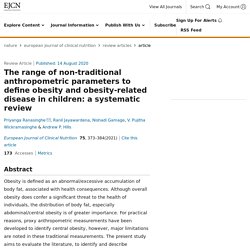
Harnessing technological solutions for childhood obesity prevention and treatment: a systematic review and meta-analysis of current applications. Study selection Qualitative synthesis Ninety-one full text articles were reviewed for inclusion; 55 articles [18,19,20,21,22,23,24, 33, 34, 38,39,40,41,42,43,44,45,46,47,48,49,50,51,52,53,54,55,56,57,58,59,60,61,62,63,64,65,66,67,68,69,70,71,72,73,74,75,76,77,78,79,80,81,82,83] representing 54 unique RCTs were identified as meeting the inclusion criteria for the qualitative synthesis (Fig. 1).
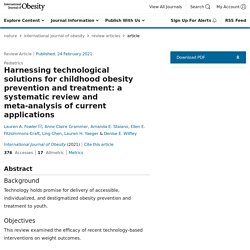
Although two articles reported on the same RCT, one provided outcomes at post-intervention [49] and the other at long-term follow-up [48]; therefore, both articles were included in the review. Ten additional studies were identified from the reference lists of the included articles. However, all 10 articles were excluded due to the following reasons: not an RCT (n = 4), no weight outcome (n = 3), no technology component (n = 2), and no full text (n = 1).
The prevalence of pediatric metabolic syndrome—a critical look on the discrepancies between definitions and its clinical importance. The prevalence of MetS among children and adolescents—findings of current scientific review Table 2 provides an overview of 31 epidemiological studies that met the inclusion criteria.
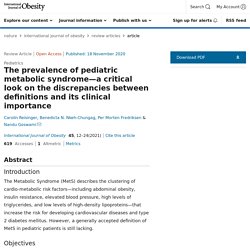
The chosen publications included both large population-based studies as well as smaller surveys, which were conducted in schools or in certain country regions. Sample sizes reached from 371 students in a South African cohort [30] to a maximum of 37,504 adolescents participating in a nationwide study in Brazil [31]. Among the 31 included papers, the prevalence of pediatric MetS ranged from 0.3 to 26.4% (see Fig. 2). The lowest prevalence (0.3%) was found in a population-based survey of Colombian school children by using the definition of the IDF [32] (see Figs. 2 and 3).
Minimum: 0.3% in Colombia [32], maximum: 26.4% in Iran [33], mean value of the whole dataset: 5.2%, median value of the whole dataset: 3.8%. The prevalence is shown as a percentage range and is depicted for selected countries. A 2 year physical activity and dietary intervention attenuates the increase in insulin resistance in a general population of children: the PANIC study.
Study design and participants The Physical Activity and Nutrition in Children (PANIC) study is a non-randomised controlled trial on the effects of a combined physical activity and dietary intervention on cardiometabolic risk factors and other health outcomes in a population sample of children from the city of Kuopio, Finland [22, 23].
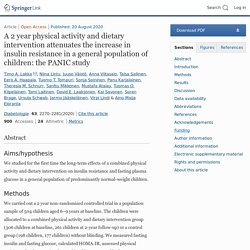
The Research Ethics Committee of the Hospital District of Northern Savo approved the study protocol in 2006 (Statement 69/2006). The parents or caregivers of the children gave their written informed consent, and the children provided their assent to participation. The PANIC study has been carried out in accordance with the principles of the Declaration of Helsinki as revised in 2008. We invited 736 children aged 6–9 years who started the first grade in 16 primary schools of the city of Kuopio in 2007–2009 to participate in the study (Fig. 1). Flowchart of the PANIC study. Paediatric obesity and brain functioning: The role of physical activity—A novel and important expert opinion of the European Childhood Obesity Group - Esteban‐Cornejo - 2020 - Pediatric Obesity. Corresponding Author E-mail address: david.thivel@uca.fr.
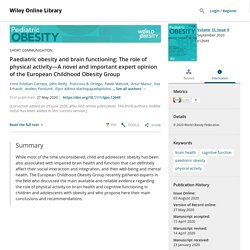
Low‐carbohydrate interventions for adolescent obesity: Nutritional adequacy and guidance for clinical practice - Jebeile - 2020 - Clinical Obesity. Low‐carbohydrate dietary patterns are re‐emerging as a popular method of weight reduction.
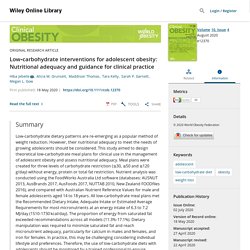
However, their nutritional adequacy to meet the needs of growing adolescents should be considered. This study aimed to design theoretical low‐carbohydrate meal plans for clinical use in the management of adolescent obesity and assess nutritional adequacy. The paediatric weight management office visit via telemedicine: pre‐ to post‐COVID‐19 pandemic - O'Hara - - Pediatric Obesity. The arrival of the COVID‐19 pandemic has significantly affected traditional healthcare delivery systems.
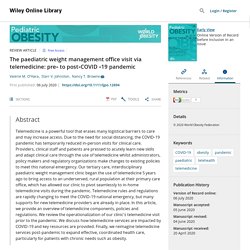
The need for social distancing along with the on‐going needs of our patients demanded that healthcare professionals create in‐person visit alternatives. The COVID‐19 pandemic has created an urgency to act, to use every tool in order to treat safely. Swift policy and regulatory changes such as reimbursed telemedicine visits directly to the patient's home have occurred at state and federal levels to provide access between patient and providers.
Hospital systems and professional organizations are mobilizing teams to support telemedicine efforts, including virtual meetings, links to resources and rapid adaptation of policies and skills. Government agencies, particularly the Centers for Medicare and Medicaid Services (CMS), are reacting to the evolving emergency with telemedicine waivers and rule changes to allow continuity of care in provider practices.1 4.2 Private payors 4.4 Security. School-based interventions. Caregiver Influences on Eating Behaviors in Young Children. Prevention of Childhood Obesity: A Position Paper of the Glo... : Journal of Pediatric Gastroenterology and Nutrition. What is known?
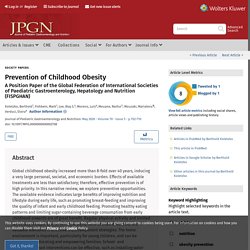
Childhood obesity prevalence markedly increased over the last four decades and induces a very high personal, societal and economic burden. Obesity Treatment Among Adolescents: A Review of Current Evidence and Future Directions. Importance Obesity in adolescence has reached epidemic proportions around the world, with the prevalence of severe obesity increasing at least 4-fold over the last 35 years.

Most youths with obesity carry their excess adiposity into adulthood, which places them at increased risk for developing obesity-driven complications, such as type 2 diabetes and cardiovascular disease, and negatively affects social and emotional health. Given that adolescence is a unique transition period marked by significant physiologic and developmental changes, obesity-related complications can also negatively affect adolescent growth and developmental trajectories. חשיפה למסכים ובריאות הילדים. A developmental cascade perspective of paediatric obesity: A systematic review of preventive interventions from infancy through late adolescence - St. George - 2020 - Obesity Reviews. The goals of this systematic review were to identify and describe paediatric obesity prevention interventions from infancy to late adolescence and to provide recommendations for future intervention research in light of a recently proposed developmental cascade (DC) model of paediatric obesity.

We conducted an electronic search of randomized controlled trials with a minimum 6‐month postintervention follow‐up published between 1995 and 2019. We included 74 interventions: prenatal/infancy (n = 4), early childhood (n = 11), childhood (n = 38), early to mid‐adolescence (n = 18), and late adolescence (n = 3). Infancy and early childhood trials targeted early feeding and positive parenting skills. Half of the childhood and adolescence trials were school based and used universal prevention strategies; those classified as selective or indicated prevention tended to involve the family for more intensive lifestyle modification.
פעילות גופנית וספורט בילדים ובני נוער. Time to solve childhood obesity: CMO special report. Treatment of Adolescent Obesity in 2020. Treating the approximately 9 million US adolescents with obesity1 is challenging because of the complex nature of this chronic disease. Global Atlas on Childhood Obesity. After agreeing at the World Health Assembly in 2013 that countries should ensure their levels of childhood obesity are no higher in 2025 than they were in 2010-2012, the latest analyses of trends in 196 countries found that 8 out of 10 countries (156) countries have less than a ten percent chance of meeting their target. “The dramatic rise in the numbers of children affected by obesity is being driven by emerging economies – in Asia, the Middle East and Latin America,” said Dr Tim Lobstein, Director of Policy at the WOF and one of the authors of the World Obesity Federation’s report.
Interventions for preventing obesity in children. Guidelines on physical activity, sedentary behaviour and sleep for children under 5 years of age. WHO 2019: To grow up healthy, children need to sit less and play more. Children under five must spend less time sitting watching screens, or restrained in prams and seats, get better quality sleep and have more time for active play if they are to grow up healthy, according to new guidelines issued by the World Health Organization (WHO). “Achieving health for all means doing what is best for health right from the beginning of people’s lives,” says WHO Director-General Dr Tedros Adhanom Ghebreyesus. “Early childhood is a period of rapid development and a time when family lifestyle patterns can be adapted to boost health gains.” The new guidelines on physical activity, sedentary behaviour and sleep for children under 5 years of age were developed by a WHO panel of experts.
They assessed the effects on young children of inadequate sleep, and time spent sitting watching screens or restrained in chairs and prams. They also reviewed evidence around the benefits of increased activity levels. Infants (less than 1 year) should: WHO guidelines on physical activity, sedentary behaviour and sleep for children under 5 years of age. Current Recommendations for Nutritional Management of Overweight and Obesity in Children and Adolescents: A Structured Framework.
Pediatric Obesity Algorithm: A Practical Approach to Obesity Diagnosis and Management. Background Childhood obesity is a growing global health problem. Despite a continual rise in the rate of childhood obesity in the United States and other developed countries over the last 30 years, there is still no clear treatment strategy. A great deal of the research effort into solving the problem of childhood obesity is directed toward prevention.
There are few evidence based studies specifically addressing the treatment of childhood obesity, thus the management and treatment of the child with obesity is left to the practitioner to use clinical judgment and persuasion to modify the family's dietary and lifestyle habits (1–3). Often, societal barriers pose roadblocks to early diagnosis and referral for treatment.